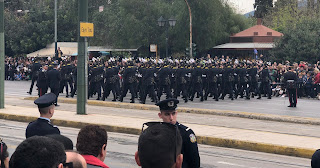 |
| East side of the Parthenon |
If there's a single iconic symbol of Athens, it's the Parthenon that sits atop the Acropolis in the middle of the oldest part of the central city. Construction began in 447 B.C., some 2500 years ago and before the time of Christ. The Parthenon was actually built as a temple to the Goddess Athena whom the people of Athens considered their patron and for whom the city is named.
There's only one way to get to the top of the Acropolis and that is to walk uphill. Our apartment was not far from the main entrance so we set out early and walked up a cobblestone walkway to the entrance. From there it became a lot steeper as we traversed multiple sets of steps making our way to the top.
 |
| Odeon of Herodes Atticus |
Our first view was that of the Odeon of Herodes Atticus. What today looks like an outdoor amphitheater was actually an enclosed structure erected in 161 A.D. An Odeon is a theater use for music concerts -- Ode is the Greek word for song. This is still used today for the occasional musical performance. There was also an outdoor amphitheater used for plays--the Theatre of Dionysus-- but it is very much in ruins and not suitable for use.
 |
| Climbing the steep steps of the Propylaea |
We climbed numerous steps through the main entrance called the Propylaea, reaching the summit of the Acropolis. Here we were greeted with our first full-on view of the Parthenon. Reconstruction and stabilization of the Parthenon has been occurring for many years, and much of the west side its still shrouded in scaffolding. Acropolis means "high city," and you will find other Greek cities with their own acropolis. The top of the Acropolis is very rocky -- great for stability and constructing these large temples, but very uneven for walking. Many of the rocks and marble have been worn smooth by wind, rain, and time, so we had to be careful as there were slick spots even on a beautiful sunny day.
 |
| Erectheion |
Also on the Acropolis is the Erectheion, a temple perhaps even more prestigious than the Parthenon. It was built on the site where the Mycenaeans had built a palace for their king. The replica Caryatids help support the roof of the porch. This temple was dedicated to both Poseidon and Athena, each side reserved for worshipping one or the other. The other major
 |
| Caryatids |
structure atop the Acropolis is the Temple to Athena Nike. It was designed by one of the architects of the Parthenon and dedicated to Athena's victory over Poseidon and for bringing victory over the Persians in 479 B.C., hoping it would ensure other victories.
 |
| Temple of Athena Nike |
It was breathtaking and awe-inspiring to see 2,500 years of history before our eyes. Even though a significant portion is in ruins, what
remains is simply an incredible testament to the ability and advancement of the Greeks to construct such masterful structures that have withstood the test of time.







































